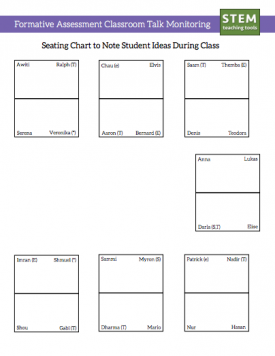Talk Resource Tool: Classroom Talk as a Formative Assessment Opportunity
While there has been significant research done about how classroom talk can be used as formative assessment (see STEM Teaching Tool #16), there are few resources on how to engage in this informal, on-the-fly type of assessment in practice. This protocol describes one way in which classroom talk can be assessed to inform instruction. There are likely many other ways that this can be done, but we have created and tested one we hope will prove useful.

PDF: Formative Assessment Tool: Student Idea Progression and Seating Chart
You will need to develop your own charts using your students, but we hope this will provide a helpful template for you to launch your design.
A fundamental assumption of this approach to informal on-the-fly formative assessment is that not all students need the same supports or resources to be successful. This approach helps you refine which students need particular supports.
How to use this Template:
Prior to classroom talk
- Decide on your assessment goal for the day. Do you want to know what every student is thinking or do you want to know how your ELL students are able to express their ideas? Or your SPED students? Or how the girls in your class are engaging in a particular practice?
- Based on your goal, determine which students you want to hear today. You will likely only be able to hear 4-6 students effectively during a classroom talk episode ranging from 10-15 minutes. Formalized written data can be collected through an exit ticket or other type of formative assessment so limit yourself during on-the-fly assessment to collect information on what you need to hear.
- On a seating chart, circle the students you will visit when the talk activity gets under way. You may want to number the students in order of priority if you really want to make sure you hear particular students but others are more optional.
- It is helpful to create a reusable seating chart on which you symbolize salient characteristics of students that may help guide your visits. Salient characteristics can include things such as ELL, TAG, SPED designations, challenges particular students have such as getting started on tasks or in the use of technology, or strengths students have in such as writing, explaining, peer collaboration, etc. An example of such a seating chart is included in the classroom talk monitoring material. We suggest confidentially surveying students to find out this information at the start of the year with some form of instructional survey.
- This seating chart can then be put inside a clear plastic sleeve, and then you can write on it in erasable pen so you can reuse the same seating chart multiple times.
- Consider using writing tools to bookended around classroom talk (as suggested in the Talk Resource Tools) to allow students initial personal time to collect their thoughts.
During classroom talk
- Using the seating chart you created, which can stay on your desk or be carried around with you on a clipboard, document what you hear before the talk activity concludes for the focal students you are listening to on this particular day. Making notes on the seating chart in understandable shorthand is efficient at this point.
- When moving around the room to hear particular students, you may want to try to be unobtrusive. One of our collaborating teachers “cleans beakers” during this time or engages in other types of non-descript tasks so that she can listen to students without them being self-conscious of her listening.
- On the other hand, other teachers make the practice of listening explicit to students so they understand what you are doing. For example, you can remind students that you will be coming around and taking notes, but that these are not evaluative notes. Instead, clarify that they are meant to be helpful thoughts you are having as you hear all the great sensemaking that students are doing.
- On a cautionary note, your goal here is assessment, so it is not helpful to interrupt groups necessarily. While you might want to ask a clarifying question at times, it may also be a good strategy, if your goal is to assess current communication practices and conceptual thinking, to keep silent. If you do this regularly during peer-peer designated talk activity, it will foster the classroom norm not to turn to the teacher for the “right” answer, but instead to engage in collaborative sensemaking.
After classroom talk
- When you have a minute to process your assessment information, it is helpful to summarize student thinking on a roster (like the roster included in the classroom talk monitoring material) or some other form of teacher sensemaking tool.
- The same roster can be used across multiple days of a lesson or even across a unit to accumulate assessment information on multiple students.
- Common patterns can be seen using this process, which can then inform instruction. For example:
- If you see that many of your ELL students are struggling to clarify others thinking, you could use a Talk Science Resource Card from the Talk Resource Tools in future peer-peer conversations.
- If you see that a number of your students are finding it difficult to draw on evidence during argumentation, you could design a mini-lesson to open up conversation about the nature of evidence versus opinion.
- Consider using writing tools to bookended around classroom talk (as suggested in the Talk Resource Tools) to document student thinking for every student more broadly.
